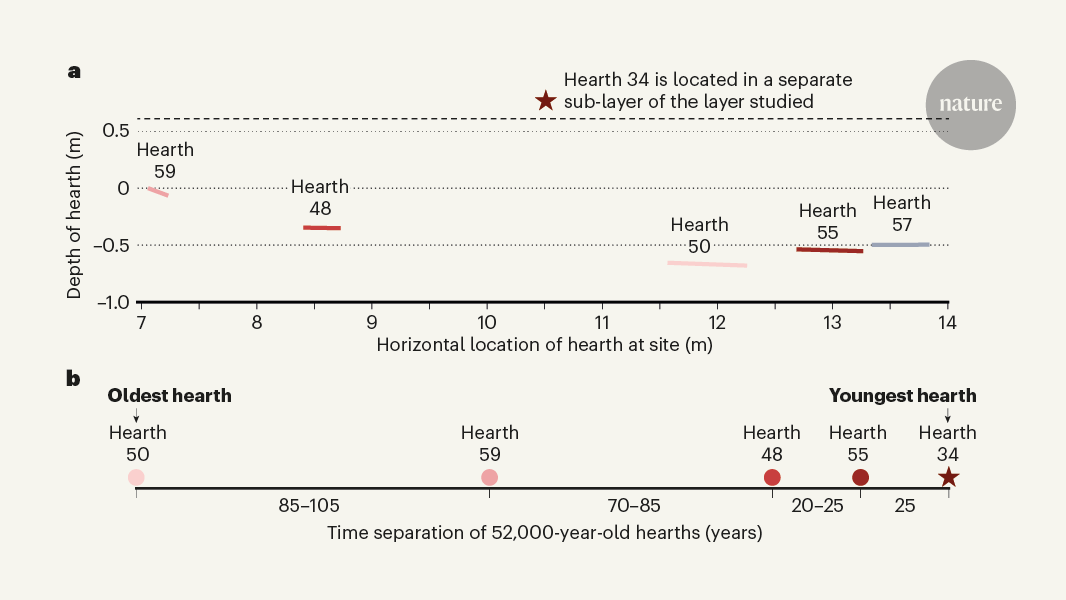insight - Computational Complexity - # Precision Dating of Ancient Fireplaces and Occupation Patterns
Precise Dating Reveals Timing of Ancient Fireplace Use and Occupation Patterns at Neanderthal Rock-Shelter Site
Core Concepts
Precise dating techniques can provide valuable insights into the timing and patterns of ancient human occupation at archaeological sites.
Abstract
The article discusses a technological advancement in the ability to precisely date the use of ancient hearths, which is crucial for understanding the occupation patterns and lifestyles of early human populations at archaeological sites. The researchers used this new dating approach to assess the timing of occupation at the entrance of a rock-shelter site associated with Neanderthals.
The key highlights and insights from the article are:
Accurate timing information about the use of ancient fireplaces and hearths is essential for reconstructing the occupational history and organization of early human populations at archaeological sites.
The researchers present a new technological approach that allows for more precise dating of the use of ancient hearths, which can provide valuable insights into the timing and patterns of occupation at these sites.
The researchers applied this new dating technique to a rock-shelter site associated with Neanderthals, allowing them to assess the timing and duration of occupation at the site's entrance.
The findings from this study demonstrate the potential of this new dating approach to enhance our understanding of the lifestyles and settlement patterns of ancient human populations, including Neanderthals, at archaeological sites.
Precision dating pinpoints time between use of ancient fireplaces
Stats
None.
Quotes
None.
Key Insights Distilled From
by Ségo... at www.nature.com 06-05-2024
https://www.nature.com/articles/d41586-024-01501-x
Deeper Inquiries
How can this new precision dating technique be applied to other archaeological sites to further our understanding of ancient human settlement and occupation patterns?
This new precision dating technique can be applied to other archaeological sites by analyzing the timing of fireplace use to establish occupation periods accurately. By dating the hearths with high precision, researchers can create a timeline of human activity at various sites, allowing for a better understanding of settlement patterns, duration of occupation, and potential seasonal variations in human presence. This information can help reconstruct ancient human behaviors, migration patterns, and societal structures, providing valuable insights into how different populations interacted with their environments over time.
What other types of evidence, in addition to the timing of fireplace use, could be used to reconstruct the social organization and daily activities of Neanderthal populations at this rock-shelter site?
In addition to the timing of fireplace use, other types of evidence that could be used to reconstruct the social organization and daily activities of Neanderthal populations at the rock-shelter site include:
Artifact Analysis: Studying the types and distribution of artifacts found in the vicinity of the hearths can provide insights into the activities conducted by Neanderthals, such as tool-making, food preparation, and social interactions.
Faunal Remains: Analyzing animal bones and remains near the hearths can reveal information about hunting practices, diet, and resource exploitation strategies of Neanderthals.
Spatial Organization: Examining the spatial layout of the site, including the distribution of hearths, living areas, and activity zones, can help reconstruct how Neanderthals organized their living spaces and daily routines.
Environmental Data: Studying pollen, plant remains, and sediment layers can offer clues about the local environment, climate conditions, and potential seasonal variations that influenced Neanderthal behavior and settlement patterns.
How might the insights gained from this study on Neanderthal occupation patterns contribute to our broader understanding of the evolution of human societies and the interactions between different human species?
The insights gained from this study on Neanderthal occupation patterns can contribute to our broader understanding of human evolution and interactions between different human species in several ways:
Cultural Evolution: By analyzing the timing and duration of Neanderthal occupations, researchers can track changes in cultural practices, technological advancements, and social behaviors over time, shedding light on the cultural evolution of early human populations.
Adaptation Strategies: Understanding how Neanderthals organized their settlements, utilized resources, and interacted with their environment can provide valuable insights into their adaptive strategies and resilience in different ecological settings.
Inter-Species Interactions: Studying Neanderthal occupation patterns can help elucidate the interactions between Neanderthals and other human species, such as Homo sapiens, and how these interactions influenced cultural exchange, genetic admixture, and ultimately, the evolutionary trajectories of different human lineages.
Comparative Studies: By comparing Neanderthal occupation patterns with those of other ancient human populations, researchers can identify commonalities, differences, and unique features of human societies across time and geographical regions, contributing to a more comprehensive understanding of the diversity and complexity of human social systems.
0
